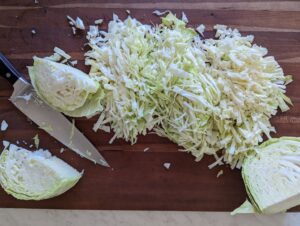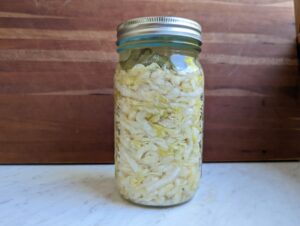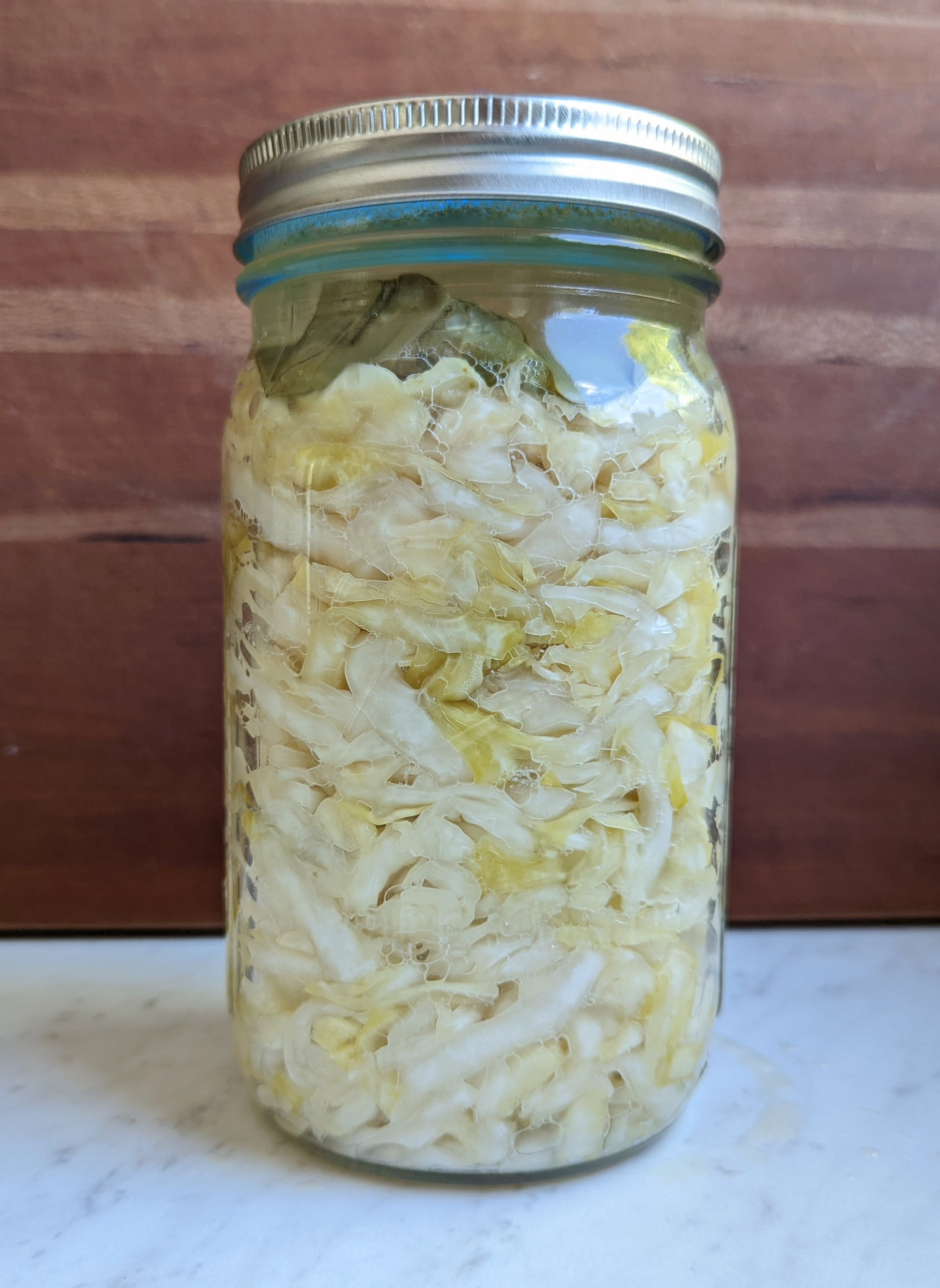Revised and updated. Originally posted March 18, 2016
In my post 3 Reasons to Eat More Fermented Foods (and Where to Find Them), I discussed some of the health benefits of eating more fermented foods and especially, fermented vegetables. They are great for you gut but the hands-down number ONE reason I eat fermented foods is because they are downright delicious.
I actually crave the tart, tangy, and slightly salty flavor of homemade kraut (just like this super simple sauerkraut). Making fresh homemade kraut is easy and utterly inexpensive compared to its store-bought counterparts.
Sauerkraut sold at most stores is in a can or a jar on the grocery store shelf. If it’s been cooked and canned, the probiotics in the sauerkraut have been killed. If you’re wanting to buy sauerkraut similar to this super simple sauerkraut recipe, be sure to get raw lactofermented kraut found in a refrigerator in the store in a glass jar or bag.
Let’s get cooking. . . or more accurately shredding, salting, and packing.
Ingredients for making Super Simple Sauerkraut
Super Simple Sauerkraut is simple and easy and contains only TWO real food ingredients.
The first ingredient is cabbage. For a 1 quart batch, find a dense head of green cabbage weighing about 2 pounds. Organic is best but if you can’t find an organic cabbage, just peel off the outer couple layers of leaves and compost them. 
If you prefer to make a Red or Ruby style kraut, you can use this exact sample Super Simple Sauerkraut recipe and just swap red cabbage for the green cabbage.
The next ingredient is the salt. Avoid using table salt that contains iodine as it will give the kraut an off metallic flavor. Pickling or kosher salt works if it’s finely ground. It’s pure but also devoid of much nutrition. I prefer using sea salt (with no added iodine) or Redmond Real Salt which is mined in Utah. When it comes to salt, just keep it simple and use what you have to get started.
Tips for making Super Simple Sauerkraut
For kraut, there are a few keys. Remember the following three “S” words and you’ll be good to go: shred, salt, submerge.
First, gather your equipment. You’ll need a large mixing bowl, a sharp chef’s knife or food processor for the cabbage, a cutting board, and the tools of fermenting such as a crock or 1 quart mason jar, weight (like a pickle pebble or 1/2 pint jar filled with water and topped with a lid), and a fermentation airlock (like a pickle pipe) or clean towel to cover. If you’d like to double, triple, or quadruple this recipe, it will work great. Just add the salt slowly and taste so you don’t over-salt the kraut. A good rule of thumb is about 1 tablespoon salt per quart.
![]() Follow the recipe carefully, especially the steps on packing the kraut. The kraut will ferment from a few days to 2 weeks or more, depending on how tart you like it. The air temperature will affect how fast it ferments. You’ll know it’s done when it’s tangy and tart and tastes delicious to you. The color will change when it’s done as well, it will look like cooked cabbage instead of fresh cabbage.
Follow the recipe carefully, especially the steps on packing the kraut. The kraut will ferment from a few days to 2 weeks or more, depending on how tart you like it. The air temperature will affect how fast it ferments. You’ll know it’s done when it’s tangy and tart and tastes delicious to you. The color will change when it’s done as well, it will look like cooked cabbage instead of fresh cabbage.
Sometimes, the waiting for it to be ready to munch on is the really really hard part. Take a deep breath, you can do it. So, get your hands on some cabbage and make it today!
 Start with this Super Simple Kraut Recipe to get the hang of making kraut then branch out and add herbs, spices, and other vegetables. Adding some shredded carrot and ginger will give you a delicious carrot ginger kraut. Adding some caraway seeds to this Super Simple Kraut will give you a traditional sauerkraut with a different flavor. Experiment, have fun, and enjoy!
Start with this Super Simple Kraut Recipe to get the hang of making kraut then branch out and add herbs, spices, and other vegetables. Adding some shredded carrot and ginger will give you a delicious carrot ginger kraut. Adding some caraway seeds to this Super Simple Kraut will give you a traditional sauerkraut with a different flavor. Experiment, have fun, and enjoy!
![]()
If you have questions or comments about this recipe, post them below. I love hearing from you.
Super Simple Sauerkraut
Ingredients
- 1 cabbage 1 small head or about ¾ medium head, note green cabbage makes naked kraut and red cabbage makes ruby kraut
- 2 teaspoons sea salt use up to 3 teaspoons per quart, it should taste pleasantly salty but not too salty
Instructions
- Remove outer cabbage leaves and set aside. Cut cabbage in half, then in quarters. Cut out some of the cabbage core. Using a large chef’s knife, finely slice all cabbage. Alternatively, you could use a food processor to “slice” the cabbage.
- Put cabbage in a large mixing bowl and add salt. Set aside for a few minutes then firmly massage mixture with your hands until liquid squeezes out of cabbage, about 2 to 10 minutes.
- Pack cabbage tightly into a 1 quart (32 ounce) canning jar using a blunt object or kraut pounder. Press often when filling the jar to remove air bubbles and to allow the brine to come above the cabbage. Leave about 1 inch headspace in the jar since the cabbage will expand as it ferments.
- Cover the shredded cabbage mixture with cabbage leaves to keep the shredded cabbage in the brine. Add a fermentation weight, boiled rock, or bag filled with water to weigh it down (if desired).
- Put a lid or fermentation air-lock on the jar. Place in a cool place out of direct sunlight.
- Allow cabbage to ferment for about 1 week for young crisp sauerkraut to about 2 weeks to 1 month for more sour, softer sauerkraut. Check on ferment and taste with a clean utensil every 2-3 days until you are happy with the flavor. If the top appears dry, pack down sauerkraut until liquid rises above the cabbage leaves.
- Store sauerkraut in the refrigerator until it’s eaten. The cold temperature will significantly slow the fermentation process.
Notes
- If you need to make a brine to cover your vegetables, mix about 1 tablespoon sea salt per 1 cup water, although this shouldn’t be necessary with kraut.
- Once you get the hang of making basic sauerkraut, experiment with adding other ingredients to the base of cabbage like beets, garlic, dill, caraway seeds, etc.


